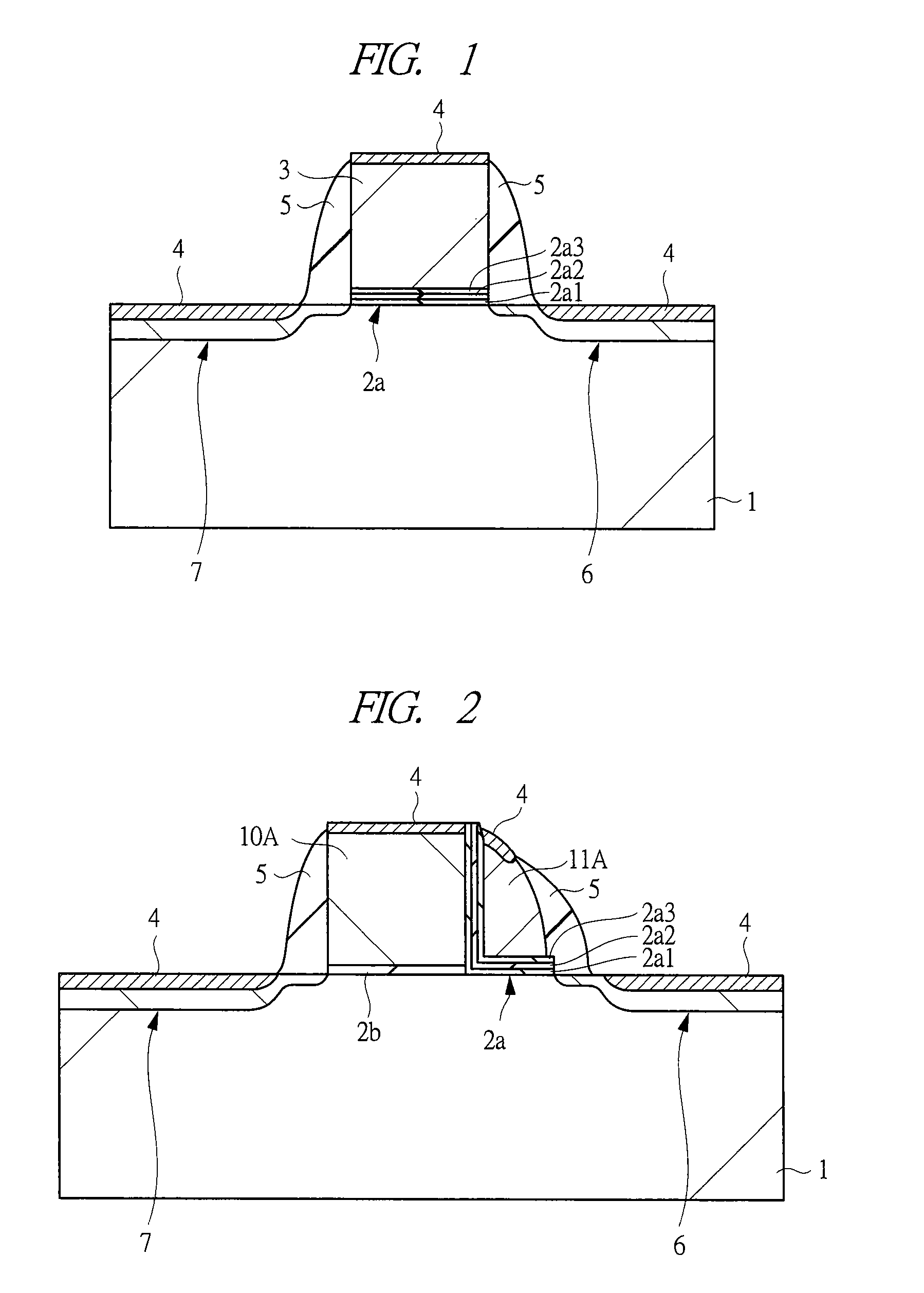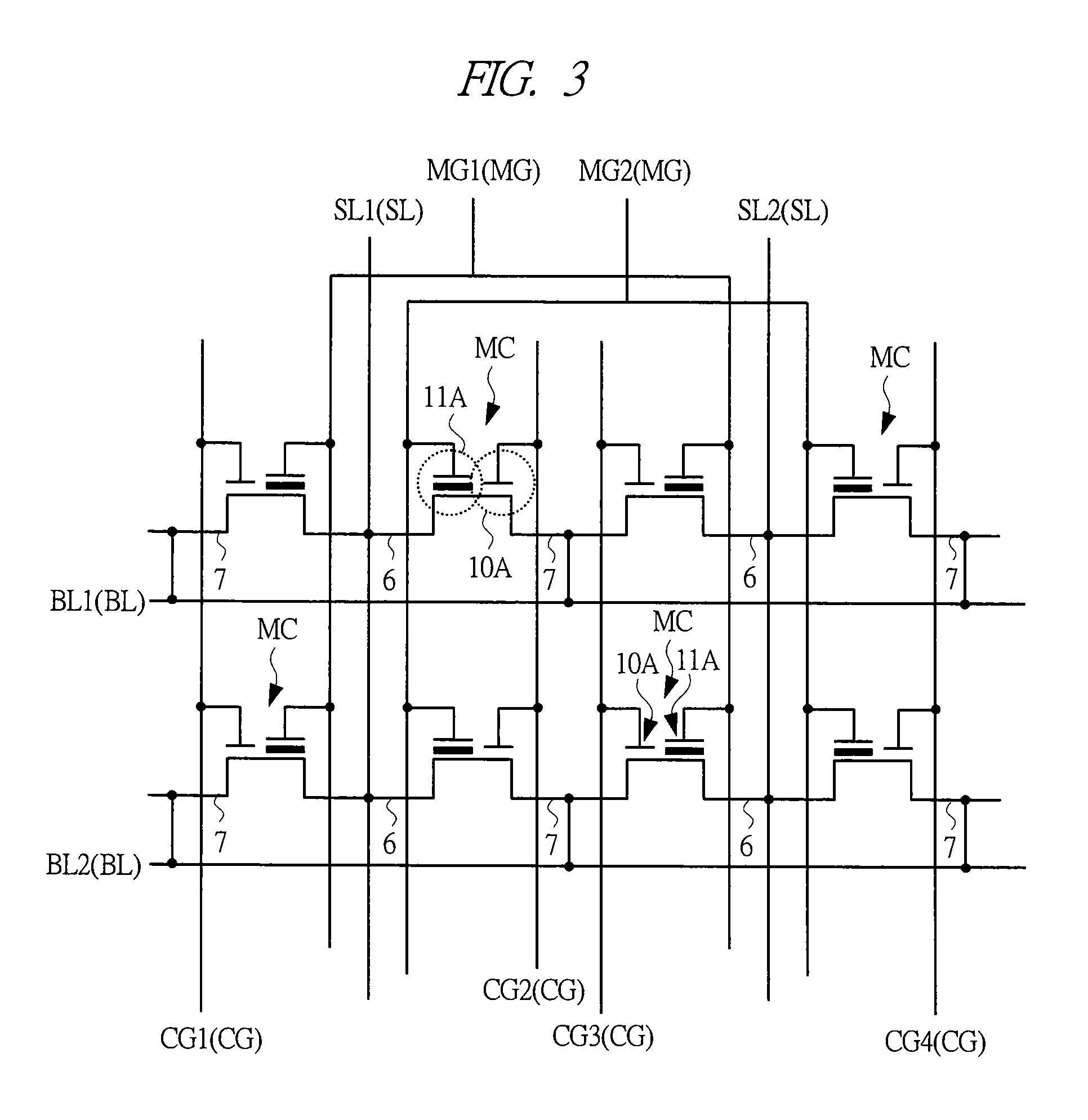Nonvolatile semiconductor memory devices with charge injection corner
a semiconductor memory and charge injection technology, applied in semiconductor devices, instruments, electrical devices, etc., can solve the problems of reducing the retention life, the scaling for a purpose of speed-up or high integration has been approaching limitation, and the structure is complicated, so as to improve the injection efficiency, speed up the write operation, and reduce the power supply circuit area
- Summary
- Abstract
- Description
- Claims
- Application Information
AI Technical Summary
Benefits of technology
Problems solved by technology
Method used
Image
Examples
first embodiment
[0095]A semiconductor device according to a first embodiment is a semiconductor device including a logic operation circuit typified by, for example, a microcomputer and a nonvolatile memory circuit provided on one and the same semiconductor substrate. A memory cell (a nonvolatile memory cell) in the nonvolatile memory circuit of the semiconductor device according to the first embodiment is a MONOS memory having a self align split-gate structure. A basic configuration of a memory cell is as explained with reference to FIG. 2 and the like. A memory array configuration is shown in FIG. 3 and a layout of a memory cell MC is shown in FIG. 4. A portion enclosed by a broken line in FIG. 4 corresponds to one memory cell MC. Arrangement of select gate electrodes 10A and memory gate electrodes 11A of memory cells MC adjacent to each other always takes a symmetrical appearance. Incidentally, regarding the above-mentioned terms, here, the term “memory gate electrode” indicates a gate electrode ...
second embodiment
[0119]As a modification of the first embodiment, a semiconductor device according to a second embodiment will be explained with reference to FIG. 29. FIG. 29 is a sectional view of a memory cell MC of the semiconductor device according to the second embodiment. In order to clarify a difference between the first embodiment and the second embodiment, an operation voltage is shown in FIG. 30. Incidentally, FIG. 30 shows a case that a potential of the semiconductor substrate 1 is set to the power source voltage Vcc to read without using any negative voltages and a case that the memory gate electrode 11A is made to be in a non-biased (Vmg=Vsub) retention state.
[0120]A voltage applied to the memory gate electrode 11A at the time of read is set to a voltage of, for example, 1.5 V which is the same power source voltage as the semiconductor substrate 1. A difference from the first embodiment is a memory gate voltage Vmg at the time of read, and by setting this voltage to be equal to that of ...
third embodiment
[0121]A third embodiment is a modification example of the structure of the semiconductor device according to the first embodiment. Part of a manufacturing flow of the semiconductor device according to the third embodiment, which is different from the manufacturing flow of the first embodiment, will be explained with reference to FIGS. 31 and 32.
[0122]First, the same manufacturing process as that of the steps of the first embodiment explained with reference to FIGS. 17 to 19 is performed in this embodiment. At this stage, a select gate electrode 10A is formed on a main face of a semiconductor substrate 1 via a gate dielectric 2b.
[0123]Subsequently, in the third embodiment, dielectric films 20a, 20b, and 20c composed of silicon oxide are formed on a side surface, an upper surface of the select gate electrode 10A, and the main surface of the semiconductor substrate 1 by performing wet oxidization of 6 nm at a temperature of, for example, 800° C., as shown in FIG. 31. In this case, in ...
PUM
 Login to View More
Login to View More Abstract
Description
Claims
Application Information
 Login to View More
Login to View More - R&D
- Intellectual Property
- Life Sciences
- Materials
- Tech Scout
- Unparalleled Data Quality
- Higher Quality Content
- 60% Fewer Hallucinations
Browse by: Latest US Patents, China's latest patents, Technical Efficacy Thesaurus, Application Domain, Technology Topic, Popular Technical Reports.
© 2025 PatSnap. All rights reserved.Legal|Privacy policy|Modern Slavery Act Transparency Statement|Sitemap|About US| Contact US: help@patsnap.com



